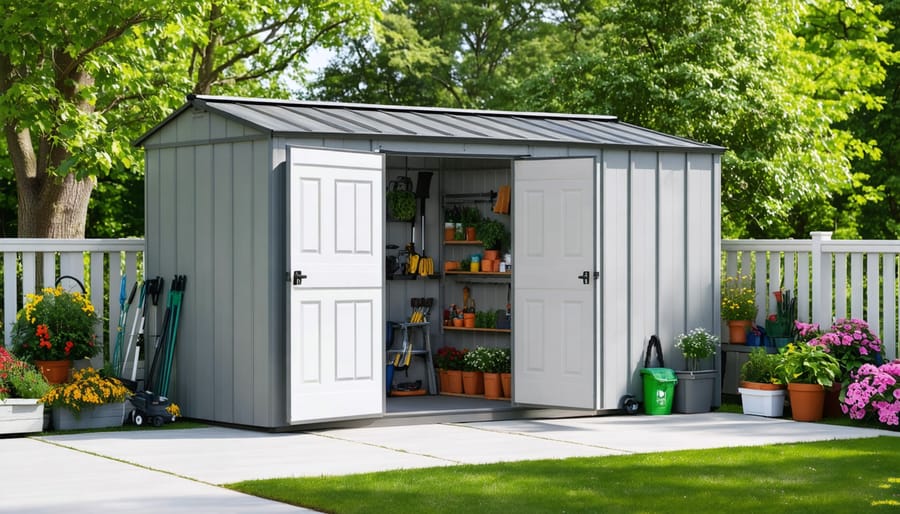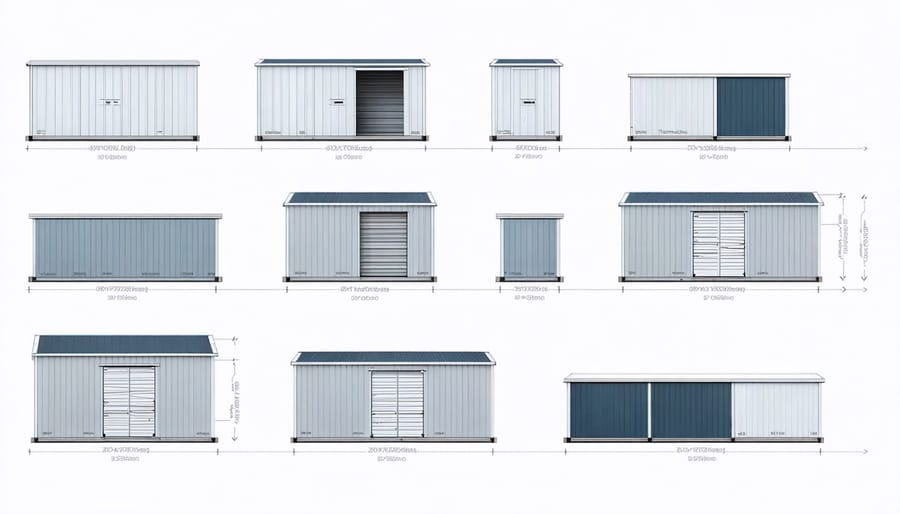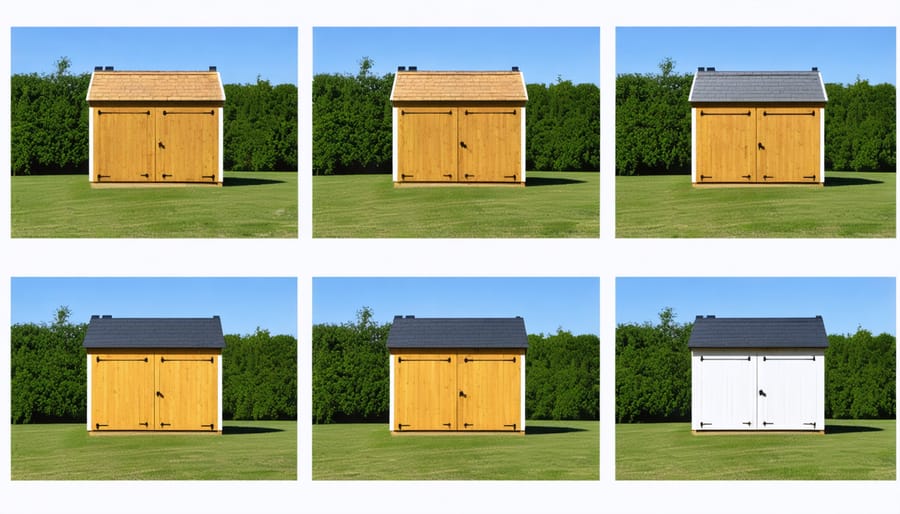Smart Space: How Expandable Storage Sheds Solve Your Seasonal Storage Struggles

Transform your limited storage space into an adaptable sanctuary with expandable storage sheds – the smart solution for homeowners who need flexible space that grows with their needs. These innovative structures combine the durability of traditional sheds with modular design elements, allowing you to expand or contract your storage capacity as seasons and requirements change.
Picture starting with a compact 8×8 base unit in spring, then easily adding a 4-foot extension when summer gardening equipment demands more space, or seamlessly incorporating a workshop area for fall DIY projects. Modern expandable sheds feature interlocking panels, telescoping roofs, and adjustable wall systems that make modifications both practical and cost-effective.
Beyond just storage, these versatile structures serve as dynamic spaces that adapt to your lifestyle – from housing holiday decorations and seasonal sporting equipment to creating temporary workspace for hobbies and projects. The beauty lies in their ability to evolve without requiring a complete replacement or major construction, saving both time and money while maintaining your property’s aesthetic appeal.
Whether you’re a first-time homeowner or a seasoned organizer, expandable storage sheds offer the perfect balance of immediate functionality and future flexibility, ensuring your investment continues to meet your changing storage needs for years to come.
What Makes a Storage Shed Expandable?
Modular Design Features
Expandable storage sheds feature a clever modular design that allows you to customize and grow your storage space as needed. These sheds are built using interlocking panels and standardized components that fit together like building blocks. The base unit typically includes essential elements like walls, a door, and a roof, while additional modules can be attached to extend the structure’s length, width, or height.
The beauty of this system lies in its flexibility. Each component is designed with connection points that allow for seamless integration with other modules. Wall panels often feature built-in channels or grooves that lock together securely, while roof sections can be extended using compatible pieces that maintain weather resistance. Some models even offer specialty modules like window units, extra doors, or shelf systems that can be added wherever needed.
The modular approach also makes installation and future modifications straightforward. Components are typically lightweight and manageable, allowing for easy assembly without heavy machinery. When it’s time to expand, new sections can be added without dismantling the existing structure, saving both time and effort while maintaining the shed’s structural integrity.

Material Considerations
When selecting materials for your expandable storage shed, durability and weather resistance should be your top priorities. High-quality resin and heavy-duty plastic composites offer excellent protection against the elements while remaining lightweight and easy to modify. These materials require minimal maintenance and won’t rust, rot, or require painting.
Metal options, particularly galvanized steel and aluminum, provide robust structural integrity and are ideal for regions with extreme weather conditions. They’re particularly effective when combined with proper proper ventilation for storage sheds to prevent condensation buildup.
For a more traditional look, treated wood remains a popular choice. Cedar and pressure-treated pine offer natural resistance to insects and decay while maintaining aesthetic appeal. However, wood requires regular maintenance to preserve its expandability features and weather resistance.
Modern polycarbonate panels are excellent for roof sections and expandable wall components, as they’re both lightweight and impact-resistant. They also allow natural light to filter through, making your storage space more user-friendly during daylight hours.
Remember to consider your local climate when selecting materials, as different environments may require specific material properties for optimal performance and longevity.

Seasonal Storage Solutions
Spring and Summer Storage
Spring and summer bring a whole new set of storage challenges as you transition from indoor to outdoor living. Your garden tools, lawnmower, and seasonal equipment need a dedicated space that’s easily accessible during these busy months. An expandable storage shed proves invaluable during this transition, offering flexible space for both active-use items and winter storage.
Create designated zones within your shed for frequently used items like gardening tools, potting supplies, and lawn care equipment. Keep these near the entrance for quick access during regular yard maintenance. Summer furniture cushions and accessories can be stored along the expandable walls, which can be adjusted to accommodate bulkier items as needed.
Consider installing adjustable shelving units that can be reconfigured based on your changing storage needs. Vertical storage solutions work particularly well during these seasons when you need to maximize floor space for larger equipment. Use wall-mounted tool organizers and overhead racks to keep items off the ground while maintaining easy access.
For optimal organization, implement a rotation system where winter items move to the back of the shed while spring and summer essentials come forward. This approach makes the most of your expandable space and ensures everything you need is within reach when you need it. Remember to leave adequate walkways and working space, especially if you use your shed for potting plants or equipment maintenance.
Fall Storage Strategies
As autumn approaches, it’s time to transition your expandable storage shed from summer mode to fall storage. Start by conducting a thorough inventory of your summer equipment. Clean and dry all garden tools, lawn furniture, and outdoor recreational items before storing them away. This prevents rust and mildew development during the winter months.
Create designated zones within your shed for different categories of items. Store frequently used fall tools like leaf rakes, tarps, and wheelbarrows near the entrance for easy access. Summer items can be tucked away in the back or upper storage areas until next season. Consider using wall-mounted storage solutions and overhead racks to maximize vertical space.
For harvest equipment and fall gardening tools, establish a dedicated workstation area. Install pegboards or tool organizers to keep everything visible and within reach. Don’t forget to make space for seasonal items like Halloween decorations and early holiday storage needs.
Pro tip: Use clear, weatherproof storage bins with labels for smaller items. This makes it easier to locate specific tools or decorations without having to dig through multiple containers. Consider adding a small dehumidifier or moisture-absorbing products to protect metal tools and sensitive equipment during the damper fall months.
Remember to leave adequate walkways between stored items for easy navigation. This becomes especially important when you need to retrieve winter equipment later in the season. Regular organization checks will help maintain an efficient storage system throughout the fall season.
Winter Storage Solutions
Winter months require special attention when it comes to storing sensitive equipment and cherished holiday decorations. Expandable storage sheds offer the perfect solution for protecting these valuable items from harsh weather conditions while keeping them easily accessible when needed.
Create dedicated zones within your shed for different categories of winter storage. Reserve a climate-controlled section for power tools, electronics, and motorized equipment that could be damaged by extreme temperatures. Consider installing moisture-absorbing products and proper ventilation to prevent condensation buildup, which can lead to rust and mold.
Holiday decorations deserve their own organized space. Use clear, weatherproof containers and label them clearly for easy identification. The expandable nature of these sheds allows you to efficiently store large items like artificial Christmas trees and outdoor decorations without cramping your year-round storage needs.
For sensitive garden equipment and summer furniture, create an elevated storage area using sturdy shelving or pallets. This prevents direct contact with the cold floor and protects items from potential water damage. Take advantage of vertical space by installing hooks and pegboards for hanging items like snow shovels and winter sports equipment.
Remember to regularly check your stored items throughout the winter months and adjust ventilation as needed. The flexibility of expandable sheds means you can modify the space as your storage needs change, ensuring your valuable items remain protected until spring arrives.
Installation and Expansion Tips
Foundation Requirements
A solid foundation is crucial for your expandable storage shed’s longevity and stability. Start by checking local building codes and obtaining necessary permits before breaking ground. The ideal foundation should be level, well-drained, and capable of supporting your shed’s maximum expanded size, not just its contracted footprint.
Concrete slabs offer the most durable foundation option, requiring a minimum 4-inch thickness and proper reinforcement. For smaller sheds, you might consider crushed stone or gravel beds, ensuring at least 4-6 inches of compacted material. Concrete pier blocks provide another alternative, particularly useful when dealing with sloped terrain.
Before installation, clear the area of vegetation, roots, and debris. Grade the soil with a slight slope away from the intended shed location to prevent water pooling. A proper moisture barrier, such as 6-mil polyethylene sheeting, should be laid beneath concrete or gravel foundations to prevent ground moisture from affecting your shed’s structure.
Consider installing a perimeter drain if your property experiences heavy rainfall or has poor natural drainage. This simple addition can prevent water damage and foundation settling over time. For areas with freeze-thaw cycles, ensure your foundation extends below the frost line to prevent seasonal movement and structural damage.
Remember, investing time and resources in proper foundation preparation will save you from costly repairs and extend your expandable shed’s lifespan significantly.
Expansion Process
Adding modules to your expandable storage shed is a straightforward process that can be completed in a single afternoon. Start by clearing the area around your existing shed structure to ensure you have ample working space. Remove any items stored against the walls where you plan to expand.
Begin by unfastening the end panel of your current shed where you’ll attach the new module. Most expandable sheds feature a panel system with simple bolt-and-nut connections that can be loosened with basic hand tools. Store these fasteners safely – you’ll need them again.
Next, position your new module against the opened end. Many manufacturers include alignment pins or guides to help you match up the connection points perfectly. Have a helper hold the module steady while you verify it’s level and square with the existing structure. Use a level tool to check both horizontal and vertical alignment.
Connect the module using the manufacturer-provided hardware, starting from the top and working your way down. Ensure all seams are properly sealed with the included weatherstripping or gaskets to maintain weatherproofing. Double-check all connections are tight and secure.
Finally, adjust the foundation supports under the new module if needed, and test the expanded structure by gently pushing against the walls to ensure stability. Most systems allow for multiple expansions, so keep your installation manual handy for future additions.
Remember to check local building codes before starting your expansion project, as size restrictions may apply in your area.

Maximizing Your Investment
Organization Systems
Maximizing your expandable storage shed’s potential starts with knowing how to organize your storage shed efficiently throughout the year. For spring and summer, create dedicated zones for gardening tools, outdoor furniture, and sports equipment. Use vertical wall organizers and pegboards to keep tools visible and easily accessible. Install adjustable shelving units that can be reconfigured as your storage needs change.
When transitioning to fall and winter, swap out seasonal items by moving summer gear to the back or upper shelves while bringing cold-weather equipment forward. Utilize clear, weatherproof containers labeled by season and contents for quick identification. Consider installing overhead storage racks for items used less frequently, such as holiday decorations or camping gear.
Make the most of your shed’s expandable features by implementing a zone system: frequently used items near the entrance, seasonal items in the expandable sections, and year-round storage in the main area. Add hooks and brackets to walls and doors for hanging longer items like rakes and shovels. Use corner spaces efficiently with triangular shelves or rotating organizers.
Remember to maintain clear pathways and review your organization system quarterly. This helps ensure your expandable shed remains functional and clutter-free, regardless of the season or storage demands.
Maintenance Tips
Regular maintenance of your expandable storage shed will significantly extend its lifespan and keep your belongings safe. Start by establishing a quarterly inspection routine to check for any loose panels, damaged seals, or signs of wear. Pay special attention to moving parts like sliding panels and expansion mechanisms, lubricating them as needed with silicone-based products.
Keep the roof and gutters clear of debris, especially during fall when leaves can accumulate. This prevents water damage and potential leaks. For metal components, it’s crucial to protect tools from rust and maintain proper ventilation to prevent moisture buildup.
Clean the exterior walls at least twice a year using mild soap and water, avoiding harsh chemicals that might damage the finish. Check weather stripping around doors and windows annually, replacing any damaged sections to maintain a weatherproof seal. If your shed has a floor, ensure proper drainage around the foundation to prevent water pooling.
For expandable features, regularly test the expansion mechanism and clean the tracks or guides. Apply weather-resistant caulk to any gaps that may develop over time, particularly around joints and seams. During winter, clear snow from the roof promptly to prevent excess weight strain on the expanding sections.
Remember to tighten any loose screws or bolts, especially after expanding or contracting the shed, as movement can cause hardware to loosen over time.
Expandable storage sheds offer the perfect solution for homeowners seeking flexible, adaptable storage that grows with their needs. Whether you’re storing seasonal decorations, garden equipment, or planning for future storage requirements, these innovative structures provide the versatility you need without compromising on quality or aesthetic appeal. By investing in an expandable storage shed, you’re not just solving today’s storage challenges – you’re preparing for tomorrow’s needs while potentially increasing your property’s value. Take the first step toward organized, scalable storage by exploring the expandable shed options that best match your space and style preferences. With proper planning and installation, your new expandable shed will serve as a lasting solution for all your storage needs, adapting seamlessly as your lifestyle evolves.

